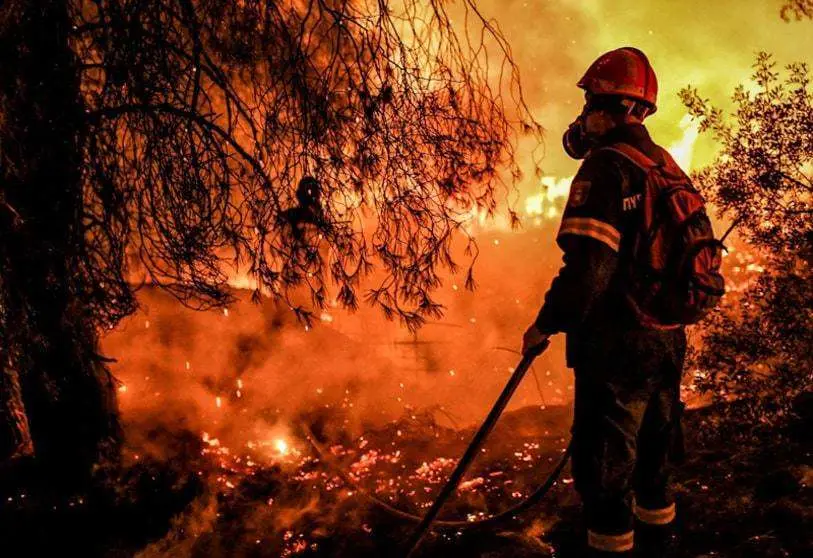Mediterranean apocalypse

I have been spending the hottest summer peaks in southern Spain for almost half a century, which on the positive side is a joy. On the negative side, the effects of undeniable climate change, or rather the climatic catastrophe that is looming over much of Spain in particular, and the Mediterranean basin in general, are being felt quite perceptibly.
This year 2021 has been particularly savage for the eastern part of the Mare Nostrum, where fires are ravaging Turkey, Greece, Albania, Montenegro, Macedonia and Croatia as never before, ravaging Bulgaria and Romania and spreading uncontrollably through Italy, especially its two large islands, Sicily and Sardinia. We are facing a veritable apocalypse, as the Greek Sotiris Donikas, head of the Euboea Coast Guard, described it, powerless to contemplate the best image of hell on earth.
Large forest fires are a small but significant and visible part of the huge and unfortunate transformation of the countries bordering the Mediterranean Sea. Year after year the figures are terrible: 19 of the hottest years in history have occurred in this 21st century, of which we are barely a fifth of the way through. This brutal curve means that hundreds of beautiful beaches in Spain and the other countries of the basin will soon disappear. And with them, hundreds of thousands of houses and buildings, or even cities that still look in the mirror of their bays: Valencia, Cadiz or Huelva, to name but a few. This is according to experts from the Intergovernmental Panel on Climate Change (IPCC), who state that 75% of Spanish territory is at serious risk of desertification.
In Malaga, for example, the average temperature is 3ºC higher than in the 1960s, when the maximum temperature recorded at that time was 42.8ºC, while this year it has already reached 46ºC. Similar records are being recorded in other Mediterranean coastal cities such as Palermo, Athens, Alexandria, Tripoli and Nice.
For greater precision, the website Climatecentral.org displays a map detailing which parts of the world will be submerged by the waters in the coming decades, and those bordering the Mediterranean are not the best off. This website explains that most of the Spanish coastline, especially the cities located on bays, will be devastated by the year 2100. This is the consequence of the fact that between 1900 and 1990 the sea level has risen by 1.3 mm per year, but since 2000 the increase has been 3.6 mm per year. At this rate, by the end of this century, global sea levels will have risen by between 29 and 59 cm, depending on the area. The evident and accelerated melting of the poles is a major contributor to this acceleration. The most striking example is that of the world's largest island, Greenland, whose temperatures this summer, which have reached 27ºC, have caused it to discharge such enormous quantities of water into the sea that it could have flooded the entire Iberian peninsula.
Weather disturbances are reaching extremes as brutal as the heatwave ravaging western Canada and the United States to the raging floods in Central Europe, some of whose German cities have left landscapes even more devastated than those of World War II.
But as far as the Mediterranean is concerned, heat waves - until the beginning of the 21st century two per year, and since 2010 up to six per year - cause unprecedented devastation. Desertification means much more than just the uncontrollable advance of deserts: it is the deterioration of soils, which are less and less capable of sustaining plants; it is the aridity of the climate and the decreasing supply of water from rivers that can alleviate the growing shortages, and it is also the best breeding ground for the spread of invasive species that cause or transmit diseases. Experts at MedECC (Mediterranean Experts on Climate and Environmental Change) estimate that for every degree of warming, the amount of rainfall decreases by 4%. This makes droughts and the risk of fires capable of devastating forests in an uncontrollable manner even more dramatic.
Erosion and flooding are and will be increasingly frequent phenomena in the Mediterranean area, with more intense and prolonged droughts and torrential rains in short periods of time, capable of destroying not only reservoirs and purification plants but also water distribution systems. This very year the Guadalquivir basin is storing the least amount of water in the last twenty-five years, a warning that restrictions may become more than a one-off measure.
The Mediterranean is also the site of a convergence of people displaced by the poverty caused by prolonged droughts. Droughts in southern Morocco and Algeria, for example, are driving people off their land who have historically made a living from agriculture, which is becoming increasingly impossible due to the growing infertility of the land.
The generalisation and virulence of a phenomenon that has historically served to accentuate clashes between neighbouring peoples should on this occasion serve to unite efforts and resources in a struggle that is unlikely to be successful if it is only carried out at the national level of each country.

